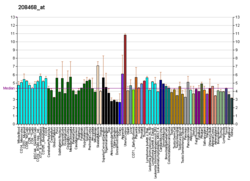SOX21
Appearance
Transcription factor SOX-21 is a protein that in humans is encoded by the SOX21 gene.[5][6] It is a member of the Sox gene family of transcription factors.
Function
[edit]In the chick embryo, Sox21 promotes neuronal cellular differentiation by counteracting the activity of Sox1, Sox2, and Sox3, which maintain neural cells in an undifferentiated state.[7]
SOX21 knockout mice display hair loss beginning from postnatal day 11. New hair regrowth was initiated a few days later but was followed by renewed hair loss. Sox21 is also expressed in the hair shaft cuticle in humans and consequently variants of the Sox21 gene could be responsible for some hair loss conditions in humans. [8]
See also
[edit]References
[edit]- ^ a b c GRCh38: Ensembl release 89: ENSG00000125285 – Ensembl, May 2017
- ^ a b c GRCm38: Ensembl release 89: ENSMUSG00000061517 – Ensembl, May 2017
- ^ "Human PubMed Reference:". National Center for Biotechnology Information, U.S. National Library of Medicine.
- ^ "Mouse PubMed Reference:". National Center for Biotechnology Information, U.S. National Library of Medicine.
- ^ Malas S, Duthie S, Deloukas P, Episkopou V (Sep 1999). "The isolation and high-resolution chromosomal mapping of human SOX14 and SOX21; two members of the SOX gene family related to SOX1, SOX2, and SOX3". Mammalian Genome. 10 (9): 934–7. doi:10.1007/s003359901118. PMID 10441749. S2CID 27862567.
- ^ "Entrez Gene: SOX21 SRY (sex determining region Y)-box 21".
- ^ Sandberg M, Källström M, Muhr J (Aug 2005). "Sox21 promotes the progression of vertebrate neurogenesis". Nature Neuroscience. 8 (8): 995–1001. doi:10.1038/nn1493. PMID 15995704. S2CID 25515445.
- ^ Kiso M, Tanaka S, Saba R, Matsuda S, Shimizu A, Ohyama M, Okano HJ, Shiroishi T, Okano H, Saga Y (Jun 2009). "The disruption of Sox21-mediated hair shaft cuticle differentiation causes cyclic alopecia in mice". Proceedings of the National Academy of Sciences of the United States of America. 106 (23): 9292–7. Bibcode:2009PNAS..106.9292K. doi:10.1073/pnas.0808324106. PMC 2695080. PMID 19470461.
- Lay summary in: Reuters Staff (May 25, 2009). "Scientists identify gene that may explain hair loss". Reuters UK.
Further reading
[edit]- Schepers GE, Teasdale RD, Koopman P (Aug 2002). "Twenty pairs of sox: extent, homology, and nomenclature of the mouse and human sox transcription factor gene families". Developmental Cell. 3 (2): 167–70. doi:10.1016/S1534-5807(02)00223-X. PMID 12194848.
- Hartley JL, Temple GF, Brasch MA (Nov 2000). "DNA cloning using in vitro site-specific recombination". Genome Research. 10 (11): 1788–95. doi:10.1101/gr.143000. PMC 310948. PMID 11076863.
- Cremazy F, Soullier S, Berta P, Jay P (Nov 1998). "Further complexity of the human SOX gene family revealed by the combined use of highly degenerate primers and nested PCR". FEBS Letters. 438 (3): 311–4. Bibcode:1998FEBSL.438..311C. doi:10.1016/S0014-5793(98)01294-0. PMID 9827568. S2CID 551497.
- Stevanović M, Lovell-Badge R, Collignon J, Goodfellow PN (Dec 1993). "SOX3 is an X-linked gene related to SRY". Human Molecular Genetics. 2 (12): 2013–8. doi:10.1093/hmg/2.12.2013. PMID 8111369.
- Denny P, Swift S, Brand N, Dabhade N, Barton P, Ashworth A (Jun 1992). "A conserved family of genes related to the testis determining gene, SRY". Nucleic Acids Research. 20 (11): 2887. doi:10.1093/nar/20.11.2887. PMC 336939. PMID 1614875.







